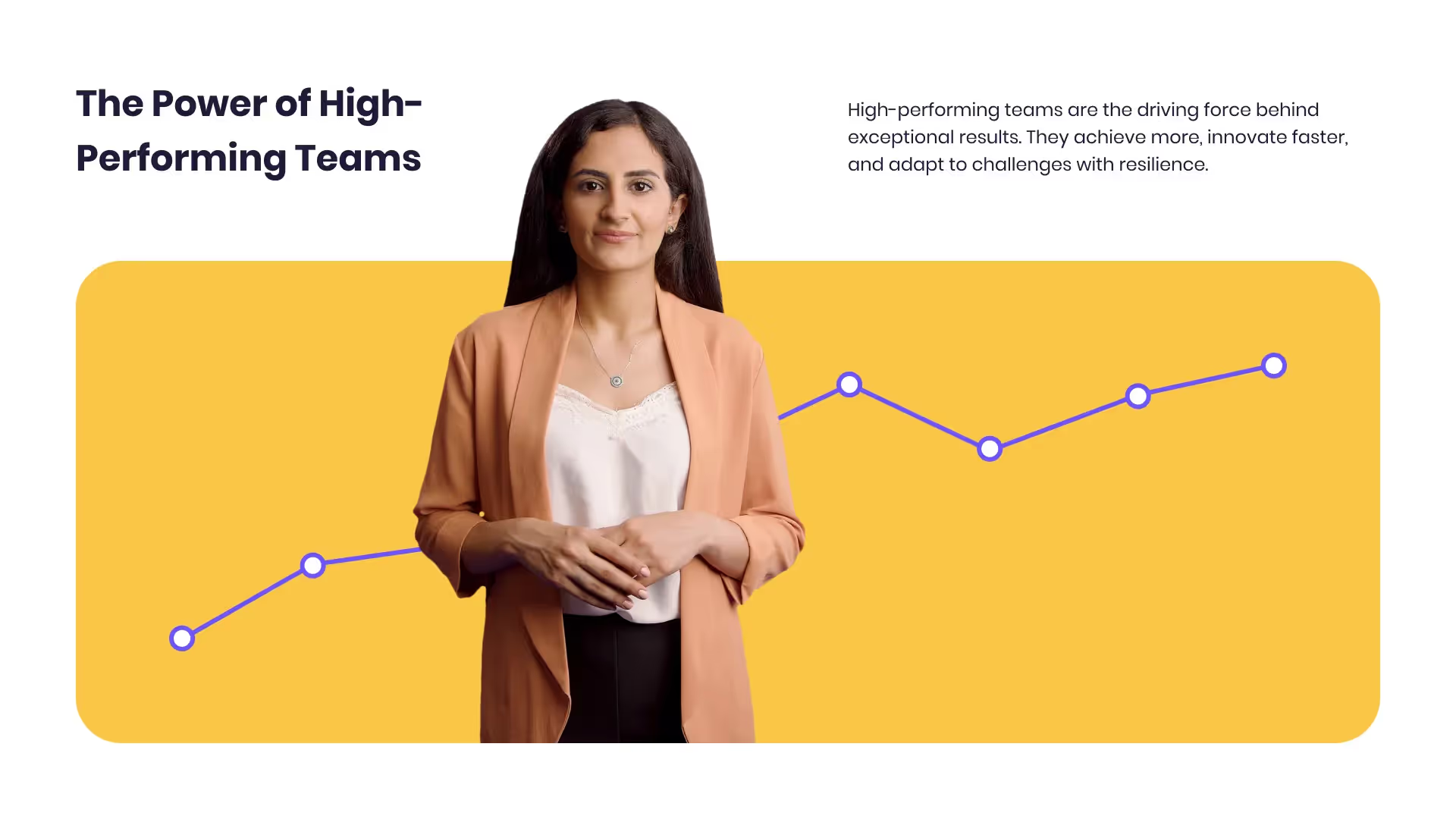Want a personalised avatar?
.avif)
Create an Instant Avatar in under a minute using your phone or camera. Fast, simple, and true to you.

Company Training Platforms: How to Build a Culture of Continuous Learning in 2025


Skills are moving faster than org charts. Many roles now change quarterly. That’s why a continuous learning culture isn’t a nice-to-have anymore; it’s how you run the business. The data backs it up. Only 30% of companies fill vacancies through internal mobility, while three-quarters of CEOs say skills shortages are a major concern.
Employees want help too: 68% of employees feel more prepared for future work due to training, yet 49% say AI development is outpacing their company’s training.
There’s also a clear business case. Good onboarding hits cost, retention, and productivity all at once.
And training affects churn: TalentLMS reduces employee turnover rates from 40% to 25%.
A continuous learning culture means you deliver always-on, skills-based paths; you update content frequently; you measure outcomes; and you put learning in the flow of work. If you can’t ship training at the speed of change, everything else suffers.
What today’s company training platforms include
Most teams blend a few systems:
- LMS (learning management system): the system of record for courses, tracking, and compliance.
- LXP (learning experience platform): discovery, recommendations, social learning.
- TMS (training management system): scheduling, logistics, invoicing, and instructor-led training operations.
You’ll also connect HRIS, SSO, CRM, and communication tools. This is where acronyms pile up. At a high level:
- SCORM: a packaging format for e-learning so an LMS can track completion and scores.
- xAPI (Tin Can): tracks learning events anywhere (apps, simulations, in the field).
- cmi5: a modern spec that combines LMS structure with xAPI flexibility.
Compliance and certification tracking now sit at the center. Audits are stricter. Teams are global. You need multilingual content, clear pass/fail data, and proof of completion on demand.
Trends: AI, mobile, and compliance
AI is no longer an add-on. It powers the admin work and the learning itself.
Reviews show how platforms use AI to personalize paths and automate work: Mitratech Perform and Deel Engage assign courses and generate dynamic quizzes aligned to goals; this increases engagement and retention when done well.
On the creation side, TalentLMS can accelerate course creation from months to a short period by transforming ideas into complete courses with assessments.
Compliance automation is a priority. Rippling connects learning to HR, payroll, and IT, automates role-based enrollments, includes pre-built compliance in 15+ languages, and reports in real time.
Engagement tactics that still work: microlearning, gamification, collaborative learning, and mobile-first layouts. This isn’t about gimmicks; it’s about reducing friction and giving people quick, relevant practice.
Budgets force trade-offs. The market is broad:
- iSpring Learn focuses on rapid authoring for SMBs.
- Moodle Workplace is budget-friendly but technical.
- Docebo leans into AI personalization and social learning for large deployments.
- Adobe Learning Manager is strong for multilingual rollouts and reporting.
- Litmos combines a simple LMS with a large library.
- TalentLMS is affordable with eCommerce and gamification.
- EducateMe blends live and self-paced delivery.
- 360Learning emphasizes collaborative learning
- SkyPrep focuses on straightforward employee training.
Building a continuous learning culture: pillars and playbook
- High-impact onboarding (0–90 days): Use structured paths, microlearning, and assessments. The gains in retention and productivity are large.
- Role-based, personalized pathways: Let AI assign content by role, performance, and learning style. Mix core skills with electives.
- Microlearning and mobile-first: Short, searchable lessons that fit daily workflows, including vertical formats for phones.
- Scenario-based practice: Branching decisions, role-plays, and labs that mirror real tasks.
- Compliance as a habit: Recurring refreshers, multilingual content, and clear proof of completion.
- Social and collaborative learning: Peer reviews, SME-led lessons, user-generated content.
- Measurement and iteration: Track completion, knowledge checks, performance after training, and internal mobility.
How to choose your platform stack
- Startup/SMB: TalentLMS for usability and gamification; iSpring Learn for rapid authoring; Moodle Workplace if you can handle technical setup.
- Mid-market: 360Learning for collaborative learning and AI authoring; EducateMe for blended live/self-paced with automations; Litmos for its library and CRM/HR integrations; SkyPrep for straightforward deployments.
- Enterprise: Docebo for AI and social learning; Adobe Learning Manager for multilingual scale; Rippling to tie training to HR/IT/payroll and automate enrollments.
- Plan for integration friction. Practitioners report WordPress/Zoom headaches, multiple login portals, TMS needs (scheduling, invoicing, CRM), high e-commerce integration costs, and Zapier enrollment issues. Aim for 90% fit and plan modest custom work for the rest.
Implementation blueprint
- Days 0–30: Discovery and pilot. Map critical roles and compliance needs. Define KPIs like time-to-productivity, completion, quiz scores, and mobility. Pilot with one team and 5–7 core modules.
- Days 31–60: Production and integration. Standardize templates. Integrate LMS with HRIS and SSO. Set up SCORM/xAPI reporting.
- Days 61–90: Scale and optimize. Expand to more roles, localize top modules, A/B test formats, publish dashboards.
Where AI video fits
I work at Colossyan, and we see the same barrier everywhere: content refresh speed. 49% say AI development is outpacing their company’s training. We help teams convert static materials into engaging, trackable video - fast.
Here’s how it works:
- Doc2Video and Prompt2Video turn SOPs, PDFs, or policies into microlearning videos in minutes. This mirrors the velocity teams want when they say course creation should take days, not months.
- PPT/PDF Import converts existing decks into narrated, animated lessons.
- Templates and Brand Kits keep everything on-brand without designers.
- Interaction adds quizzes and branching for scenario practice. You can simulate a harassment reporting decision or a safety escalation in minutes.
- Analytics show plays, time watched, and quiz scores. Export CSV for leadership reviews.
- Export as SCORM 1.2/2004 to push pass/fail data into your LMS and close the loop on compliance.
- Instant Translation localizes narration, on-screen text, and interactions. Pair with multilingual avatars and cloned voices. This aligns with the multilingual needs you see in enterprise LMS deployments.
For practice and storytelling, we use avatars and Conversation Mode to build two-person role-plays for coaching, customer scenarios, and code-of-conduct dilemmas. Gestures and animation markers add emphasis. Media and screen recording let you demonstrate software steps alongside a presenter. If you run Virtual Labs elsewhere, you can use a Colossyan video for pre-lab context and a post-lab debrief, with embedded quizzes to check comprehension.
On scale and control, we offer workspace management, content libraries, and embeds for intranet or WordPress, plus SCORM export to your LMS - useful when integration stacks are messy.
Example program blueprints you can replicate
- AI literacy for non-technical roles: Ten 5-minute videos with quizzes, translated into the top five languages. We build from your AI policy using Doc2Video, add branching for ethical vs. risky scenarios, export SCORM, and track gaps via analytics.
- Compliance sprint for distributed teams: Three microlearning modules with scenario quizzes. We use Conversation Mode for real-life dilemmas, set SCORM pass marks, and export CSV before audits.
- Manager essentials and coaching: Weekly 7-minute episodes with role-plays and reflection questions. We clone your VP’s voice for authenticity and keep visuals consistent with your Brand Kit.
- Product updates and feature rollouts: Vertical mobile lessons with screen recordings and a one-question check per module. We resize the canvas to 9:16 for field teams.
- Internal mobility academy: Cross-skilling pathways mapped to in-demand roles with peer tips. We create Instant Avatars of internal SMEs, add multilingual variants, and correlate completions with internal applicants.
Measurement and ROI
Track what leaders care about and what learners actually do:
- Time-to-productivity for new hires (target a 30–50% reduction).
- Completion and quiz pass rates by role and region.
- Compliance completion before deadlines; audit readiness with SCORM pass/fail logs.
- Retention and internal mobility. Set goals that match what others report: training tied to turnover falling from 40% to 25%.
- Engagement by device and watch time per module.
In Colossyan, I look at scene-level drop-off and quiz misses, then rewrite with our AI assistant, tighten pacing, and localize where needed. For fast-changing areas like AI tools or product features, we refresh monthly via Doc2Video or PPT imports.
Practical Colossyan workflows mapped to common needs
- Rapid onboarding from SOPs: Upload SOP PDFs with Doc2Video, apply a Brand Kit, add quizzes, set a SCORM pass mark, export, and track watch time and scores.
- Compliance refreshers with audit-ready data: Use Templates and Conversation Mode for scenarios; export SCORM 2004 with completion criteria; export analytics CSV before audits.
- Sales role-play academy: Two avatars in Conversation Mode, branching decisions, a cloned Sales VP voice, and per-scene previews to refine pacing.
- Global policy updates: Instant Translation for scripts, on-screen text, and interactions; choose multilingual avatars; adjust layouts if text expands; generate separate drafts per language.
- Product how-tos: Import PPT from release decks, add screen recordings, and set a vertical 9:16 canvas for mobile consumption.
The core idea is simple: pick a platform stack that fits 90% of your needs, then speed up content production and refresh cycles. Keep lessons short, practical, and measurable. And when skills shift - especially around AI - ship updates weekly, not yearly. We built Colossyan to make that pace realistic.

Networking and Relationship Building
Use this template to produce videos on best practices for relationship building at work.

Developing high-performing teams
Customize this template with your leadership development training content.

Course Overview template
Create clear and engaging course introductions that help learners understand the purpose, structure, and expected outcomes of your training.
Frequently asked questions





Didn’t find the answer you were looking for?















%20(1).avif)
.webp)

